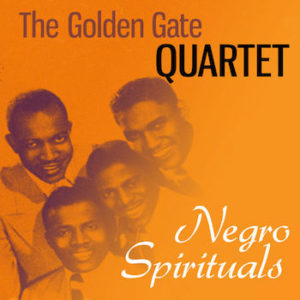
the Golden Gate Quartet
*This date celebrates the formation of the Golden Gate Quartet in 1934. They were one of the early Black Gospel singing groups in America.
The story of the Golden Gate Quartet begins in the early 1930s at a barbershop in the Norfolk, Virginia, suburb of Berkeley. Here, owner A. C. "Eddie" Griffin, a tenor singer, and Robert "Peg" Ford, a one-legged bass vocalist, enlisted two Booker T. Washington High School glee club members, tenor Henry Owens and baritone Willie Johnson, to form a quartet singing gospel music in the new "jubilee" style that was beginning to sweep through Virginia churches.
Virginia's gospel music was looser and more rhythmic than the older Alabama gospel tradition, with its trademark dependence on formal song structure and straight-ahead harmonies. Influenced by such varying sources as the pop group Mills Brothers, the swinging jazz of the Three Keys, and the emotional wailing of area pulpit preachers, jubilee singing was a bolder and more exciting gospel music geared for the body and the soul. It was the youthful energy of jubilee that Griffin sought to strap up with Owens and Johnson in his group, and that indeed came true.
The quartet eventually gained enough recognition that, by 1935, they were regularly venturing into neighboring Virginia towns such as Richmond, Tidewater, and even parts of the Carolinas for personal appearances. By this time, Griffin’s modest ambitions had been more than fulfilled. As he felt more specific about his hair-cutting business than a singing career, he retired from the quartet, replaced by Portsmouth tenor William Langford, a veteran of several area singing groups. In the summer of 1936, as the ailing Ford began to miss more and more of the Gates’ growing number of engagements, Johnson, Owens, and Langford succeeded in talking the parents of 16-year-old bass singer Orlandus Wilson (their favorite fill-in for Ford) into permitting their son to join the group as a permanent member.
With Wilson aboard, the look and sound of the group struck a new balance. Each of the four brought their specific talent. Langford was a showy, melodramatic lead singer in the standard barbershop/pop mold, with a tremendous range that allowed him to slide from baritone up to a falsetto soprano easily. Johnson, the most jazz-influenced of the group, had developed a grin-and-wink hipster narrative style the likes of which gospel music had never before seen. Owens, probably the best pure singer in the quartet, was a master at harmonic invention, allowing him to shuttle between Langford and Johnson’s leads as the arrangements warranted. And Wilson, the bass singer, anchored the foursome’s songs with an intrinsic sense of timing and syncopation that allowed them to jump, glide, bounce, and swing.
Together, they were poised to set gospel music on its ear. Through regular appearances on radio programs in Columbia, SC, and Charlotte, NC, and with performing dates in churches throughout Virginia and the Carolinas, the Golden Gate Quartet was the hottest gospel act by the middle of 1937. That August, Eli Oberstein recorded the Gates in a field recording session at the Charlotte Hotel, and so primed was the group that they laid down fourteen tracks in two hours flat. The release of their debut 78, the signature song, Golden Gate Gospel Train, brought them immediate recognition and the quartet’s highly successful recording career was on its way. That same year, the group made several appearances on NBC’s "Magic Key" variety program. In 1938, they played alongside Count Basie, Benny Goodman, Big Joe Turner, and James P. Johnson at his history-making "Spirituals To Swing" concert at Carnegie Hall.
That concert led to an engagement on a weekly radio show on CBS and a long-term run at New York’s ultra-chic Cafe Society Club. This allowed them to be seen by celebrities, including the President of the United States, Franklin D. Roosevelt, at his January 1941 inaugural gala at Constitution Hall. The Golden Gate Quartet made their final RCA-Victor recordings at a milestone in June 1940 with legendary folk singer Leadbelly. Not long thereafter, lead singer William Langford left the Gates to form a new group, the Southern Sons, and old friend Clyde Riddick took his place. The 1940s found the group making cameo appearances in some films, including Star-Spangled Rhythm, Hollywood Canteen, and A Song Is Born, and continuing to record (for Columbia and Mercury).
In 1948, Willie Johnson left, but the Gates were able to absorb the loss, as well as Owens's departure in 1950 to become a preacher. The group underwent several more personnel changes during the early fifties, as rhythm ‘n’ blues and rock ‘n’ roll became more popular in the U.S. Still, when they made their initial European tour in 1955, they found a new worldwide audience waiting for them. They’ve primarily lived and worked in Europe for the last thirty-plus years.
Riddick and Wilson have anchored the top and bottom of the trademark Golden Gate Quartet sound, with second tenor Clyde Wright (a member on and off since 1954) and baritone Paul Brembly (a member since ‘71) rounding out the group’s current and still extremely energetic, lineup.
Library of Congress
101 Independence Avenue S.E.
Washington D.C. 20540